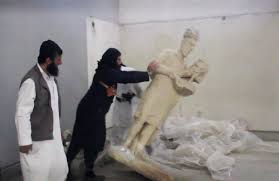The head of UNESCO has condemned the destruction of the ancient Assyrian city of Nimrud in Iraq by the so-called ’Islamic State of Iraq and the Levant’ (ISIL) takfiri group, saying it amounted to a "war crime".
 The head of UNESCO has condemned the destruction of the ancient Assyrian city of Nimrud in Iraq by the so-called 'Islamic State of Iraq and the Levant' (ISIL) takfiri group, saying it amounted to a "war crime".
The head of UNESCO has condemned the destruction of the ancient Assyrian city of Nimrud in Iraq by the so-called 'Islamic State of Iraq and the Levant' (ISIL) takfiri group, saying it amounted to a "war crime".
"I condemn with the strongest force the destruction of the site at Nimrud," Irina Bokova said in a statement.
"We cannot stay silent. The deliberate destruction of cultural heritage constitutes a war crime, and I call on all political and religious leaders in the region to stand up against this new barbarity."
ISIL terrorists have looted and bulldozed the ancient city, the Iraqi government said, in their latest assault on some of the world's greatest archaeological and cultural treasures.
A tribal source from the nearby city of Mosul told Reuters news agency that ISIL, who dismisses Iraq's pre-Islamic heritage as idolatrous, had pillaged the 3,000-year-old site on the banks of the Tigris river.
The assault against Nimrud came just a week after the release of a video showing ISIL gunmen smashing museum statues and carvings in Mosul, the city they seized along with much of northern Iraq last June.
"Daesh (Arabic acronym of ISIL) terrorist gangs continue to defy the will of the world and the feelings of humanity," Iraq's tourism and antiquities ministry said.
"In a new crime in their series of reckless offences they assaulted the ancient city of Nimrud and bulldozed it with heavy machinery, appropriating the archaeological attractions dating back 13 centuries BC," it said.
Nimrud, about 30km south of Mosul, was built around 1250 BC.
Many of its most famous surviving monuments were removed years ago by archaeologists, including colossal Winged Bulls which are now in London's British Museum and hundreds of precious stones and pieces of gold which were moved to Baghdad.
Archaeologists have compared the assault on Iraq's cultural history to the Taliban's destruction of the Bamyan Buddhas in 2001. But the damage wreaked by ISIL, not just on ancient monuments but also on rival Muslim places of worship, has been swift, relentless and more wide-ranging.
Last week's video showed them toppling statues and carvings from plinths in the Mosul museum and smashing them with sledgehammers and drills. It also showed damage to a huge statue of a bull at the Nergal Gate into the city of Nineveh.
Archaeologists said it was hard to quantify the damage, because some items appeared to be replicas, but many priceless articles had been destroyed including artefacts from Hatra, a stunning pillared city in northern Iraq dating back 2,000 years.
In July, ISIL destroyed the tomb of the prophet Jonah in Mosul. It has also attacked several places of worship and last year gave Mosul's Christians an ultimatum to convert to Islam, pay a religious levy or face death by the sword. It has also targeted the Yazidi minority in the Sinjar mountains west of Mosul.